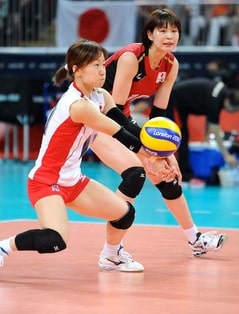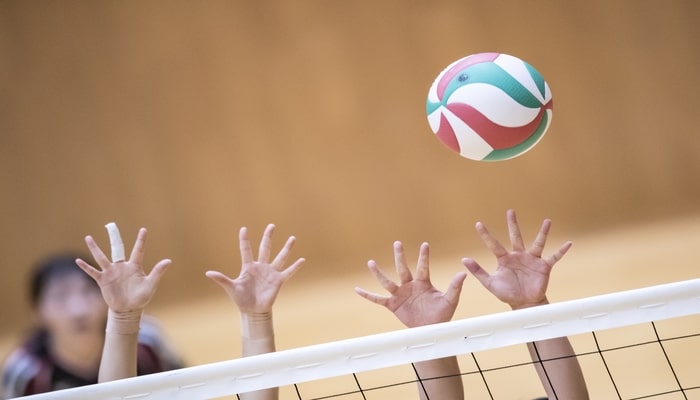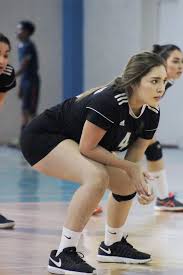
Volleyball is a strategic sport, with players in each position having specific roles and moves.
In this article, we will focus on the main positions in volleyball and their movements.
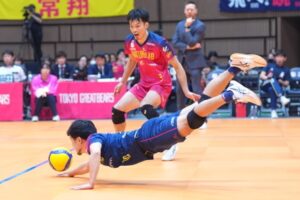
目次
setter
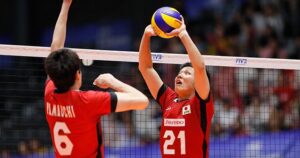
The setter is the orchestrator of the volleyball team and the central figure in the play.
Their role is diverse, controlling the flow of the game and being responsible for setting up the attack.
We will explain in detail the movement and role of the setter.
Main role of setter
game makeup
- The setter determines the team’s attack pattern and distributes the ball to the attackers at the appropriate time. This distribution shapes the team’s attacking strategy.
- Setters must always be aware of their teammates’ positions, the opposing team’s defensive layout, and the game situation to choose the most effective attacking option.
communication
- The setter is the center of communication for the team, constantly communicating with teammates during play and giving instructions for the next play.
- From pregame strategy meetings to moment-of-the-moment decisions during a match, the setter also plays the role of communicating team strategy.
setter movement
positioning to the ball
- The setter moves quickly around the court to get the best position to receive the ball after receiving it. This movement is the basis of the attack setup.
- For an effective setup, the setter must predict where the ball will land and quickly adjust their position.
Setting
- A setter’s primary skill is accurate setting. This requires the ability to send the ball to the appropriate height, speed, and direction.
- Setters use various types of sets, such as quick, high ball, and shoot, depending on the type of attacker and the opponent’s defensive situation.
defense and covering
- The setter also participates in defense, especially covering when his team’s attack is blocked. This allows you to continue to maintain an opportunity to attack.
- Setters are actively involved in defense not only when they are in the front row, but also when they are in the back row.
Tactical use of setters
The tactical use of a setter depends largely on the team’s strategy.
The setter must distribute the ball optimally according to the situation in order to control the team’s offensive rhythm and break down the opposing team’s defense.
Additionally, setters can also be an attacking option, so it is important to use dumps and sneak attacks to confuse the opposing team.
More than just a technical role, a setter also serves as the emotional backbone of the team.
Their leadership, judgment, and trust in their teammates are essential to the team’s success.
Outside hitter (left side attacker)
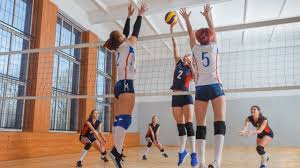
Outside hitters are the key to the attack in volleyball, and they also play an important role on the defensive side.
They mainly play on the left side of the court, and in addition to serving as the team’s scoring source, they are also actively involved in serve-receiving and defense.
We will explain in detail the movements and roles of outside hitters.
Main role of outside hitter
Role in attack
- Primary Attacker: The outside hitter is the team’s primary attacker and is responsible for many of the spike attacks. They must have a combination of height, power, and technique, and the ability to break through the opponent’s blocks.
- Diverse attacks: Outside hitters use a variety of attacks depending on the situation, such as direct power spikes, attacks from different angles, and chip shots.
Defensive role
- Serve Receive: Outside hitters also play a central role in serve receive.
- Stable receiving is the foundation of a team’s offensive setup.
- Defense: Outside hitters located at the front of the court not only block the opponent’s attacks, but also participate in defense in the backcourt.
Outside hitter movement
Movement during attack
- Approach: An outside hitter’s attack begins with an effective approach. Hit a powerful spike by approaching with fast steps and jumping at the optimal timing and position.
- Spikes: When spiking, aim for weak points in the opponent’s court, avoid blocks, or use blocks to score points.
movements in defense
- Blocking: Outside hitters especially participate in blocking against opposing attacks. To block effectively, you need to predict your opponent’s attack pattern and jump at the right time.
- Backcourt Defense: Outside hitters are involved in defense in both the front and back rows. In the back row, excellent digging techniques are required to cover a wide area and catch powerful spikes and chip shots.
Tactical use of outside hitters
Outside hitters can greatly influence the team’s tactics using their offensive and defensive abilities.
When attacking, identify the weaknesses of the opponent’s block and use effective spikes to accumulate points for your team.
On defense, he uses stable receiving and backcourt defense to neutralize the opponent’s attacks and provide his team with opportunities to counterattack.
The outside hitter is a versatile position that requires players to contribute to the team in all aspects of the game.
Therefore, high technical ability, tactical understanding, and an awareness of team play are essential.
Middle blocker: key to defense

The middle blocker is the core of the volleyball team’s defense, and also plays an important role in the attack.
They play in the center of the court and their main task is to block the opponent’s attacks, and on the offensive side they create scoring opportunities through fast breaks and quick plays.
We will explain in detail the movements and roles of the middle blocker.
Main role of middle blocker
role in defense
- Blocking: The middle blocker is responsible for blocking the opponent’s attacks, especially quick attacks from the center and attacks to the diagonal. This position requires high jumping power and quick reaction times. A successful block prevents the opponent’s attack and provides the team with a counter-attack opportunity.
- Court Coverage: If the block is missed, the middle blocker must quickly participate in the formation of the defense and cover a wide area, especially in the middle.
Role in attack
- Quick attack: The middle blocker also plays an important role in attack, reacting quickly to low tosses from the setter and launching quick attacks. This breaks down the opponent’s defense and creates scoring opportunities.
- Combination play: Middle blockers work together with other attackers to diversify attack patterns. This draws the attention of opposing blockers and provides an attacking opportunity for your teammates.
middle blocker movement
blocking movement
- Reading and positioning: The middle blocker reads the movements of the opposing setter and quickly moves in the direction of the expected attack. At this time, pay attention to the movements of the opponent attacker and take an effective blocking position.
- Timing and Jumps: Precisely timed jumps are essential for effective blocking. The middle blocker watches the movement of the ball and the opponent attacker at the same time and jumps at the optimal moment.
attack movement
- Approach: When attacking, the middle blocker uses a fast approach and jumps in response to the toss from the setter. This move is also important for deceiving opposing blockers.
- Spikes: In order to hit a powerful spike, it is important to hit the ball high. Middle blockers utilize their approach speed and jumping power to perform effective attacks.
Tactical use of middle blockers
Middle blockers greatly influence both the defense and offense of their team through their movement and playstyle.
Their play disrupts opposing teams’ attacking strategies and brings variety and unpredictability to their own attacks.
Therefore, middle blocker is a very important position that requires advanced technique, good understanding of the game, and cooperation with the team.
Right side hitter (opposite)

The right side hitter (opposite) position in volleyball plays an important role in both offense and defense.
This position is expected to keep the team balanced and provide strong blocks and effective counterattacks against the opposing team’s attacks.
Let’s delve into the main movements and roles of a right-side hitter.
Right side hitter role
Role in attack
Right-side hitters play an important role in a team’s offensive strategy.
They primarily play on the right side of the court and are expected to receive sets from the setter and hit powerful spikes.
In addition, right-side hitters need to make smart plays such as angular attacks and changing courses in order to break through the opposing team’s blocks.
role in defense
Defensively, the right-side hitter is primarily responsible for blocking attacks from the opposing team’s outside hitters.
Their position is key to effectively blocking against the opponent’s main attacker.
Successful blocks improve your team’s defense and create counter-attack opportunities.
right side hitter movement
Movement during attack
Right-side hitters use fast approaches and high jumps to deliver powerful spikes when attacking.
They may attack from different positions on the court depending on the pass from the setter.
Therefore, a variety of attack techniques and situational judgment skills are required.
movements in defense
When defending, right-side hitters read the opponent’s attack near the net and position themselves to make effective blocks.
When blocking, it is important to anticipate the opponent’s spiker’s intentions and jump at the right time.
Also, if a block comes off, you need to quickly set up your defense.
transition movement
Right-side hitters also play an important role in transitioning from offense to defense and from defense to offense.
After the opportunity to attack ends, you must quickly return to your defensive position and be ready to attack when the opportunity arises again.
Tactical use of right side hitters
The right-side hitter has a multifaceted role in the team’s tactics.
They are key players in attacking to break the opposing team’s blocks, and in defense they act as blockers to shut down the opponent’s main attacker.
He is also expected to contribute in serve receive and dig, supporting the team’s defense.
Right-side hitters are versatile players who can contribute to the team both offensively and defensively.
Understanding their movements and roles is essential for the team to develop more effective tactics.
Libero
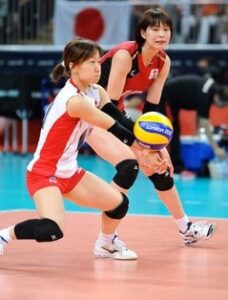
The role of a libero in volleyball is specialized in maximizing the team’s defensive ability.
This position was introduced by the International Volleyball Federation (FIVB) in 1998 to contribute to the team, especially on the defensive side.
Although the libero cannot directly participate in the attack, he plays an important role in serve receiving and digging (the technique of catching the opponent’s attack).
We will explain in detail the movements and roles of the libero.
Main role of libero
defensive specialist
Libero is a position that specializes in increasing the team’s defensive ability.
They are expected to effectively counter the opponent’s attacks and provide additional attacking chances for the team.
Since the libero is limited in his ability to participate in the attack, this position is filled by a player who has excellent defensive skills and can move quickly on the court.
Stabilization of serve receive
The libero also plays a central role in serve and receive.
They support the team’s offensive setup by reliably receiving the opponent’s serves and providing quality passes to the setter.
The libero’s play increases the team’s attacking opportunities and can advance the flow of the game in their favor.
libero movement
Positioning and forecasting
It is important for liberos to predict their opponent’s attack patterns and position themselves effectively.
They must constantly adjust their position on the court to be in a position where they can receive the opponent’s attacks most effectively.
This requires the ability to understand the tendencies of opposing players and read the development of play.
dig and receive
The core of a libero’s technical skill set is digging and receiving.
The libero is responsible for making sure to catch the opponent’s powerful spikes and serves and passing the ball to his teammates.
To achieve this, you need good reaction speed, body flexibility and precise ball control.
communication
Liberos also play a central role in communicating with teammates on the court.
They may adjust the team’s positioning when defending and give instructions to teammates when serving and receiving.
Effective communication skills are essential to understanding and implementing your team’s defensive strategy.
Tactical use of libero
How a libero is used depends on the team’s tactics and the opponent’s attacking style.
In order to effectively utilize liberos, it is important to maximize their defensive skills and strengthen the team’s defensive structure.
Another key to success is for the libero to be actively involved in the team’s defensive strategy and provide defensive leadership.
The libero is the key to the defense of a volleyball team, and his movements and role have a major impact on the team’s success or loss.
With his strong technical ability and tactical understanding, the Libero will be a valuable asset to the team.
defensive specialist

Defensive specialist (DS) in volleyball is an important position to improve the team’s defensive ability.
Defensive specialist role
defense expert
As the name suggests, a defensive specialist has a role that specializes in defense.
They help strengthen the team’s serve-receive and dig skills (the technique of catching an opponent’s attack without letting it fall to the ground).
In particular, he is expected to perform effective defense against the opponent’s powerful spiker.
Stabilization of serve receive
Defensive specialists also play an important role in serve and receive.
They help the team set up the attack by ensuring they receive serves and providing quality passes to the setter.
Players in this position must have high concentration and accurate judgment.
Strengthening floor defense
DS, who is good at playing at the back of the court, tenaciously digs out the opponent’s attacks and creates additional attacking opportunities for the team.
Their quick feet and good anticipatory abilities are essential to neutralize the opponent’s attacks and increase their chances of scoring points.
Defensive Specialist Movement
positioning
Defensive specialists must always take the most effective position on the court.
This involves reading the attacking tendencies of opposing players and quickly positioning yourself in likely attack areas.
Communication is also important for them to coordinate with their teammates and avoid duplication of defense.
dig
Digging is one of the key skills of a defensive specialist.
They keep a low stance with their knees bent and use their arms to precisely control the ball.
This movement requires high reaction speed and body flexibility.
serve receive
On serve receive, the DS quickly determines the direction and speed of the serve and positions his body appropriately to receive the ball.
The goal here is to provide a consistent pass for the setter to play easily.
Tactical use of defensive specialists
Matchups against specific attackers
Defensive specialists are often placed against the opposing team’s main attacker.
He will be the key player to block that attack.
Changing the flow of the game
A good play from a defensive specialist can change the course of a game.
Their tenacious defense gives the team momentum and can de-motivate the opposing team.
As the name suggests, a defensive specialist is a position that specializes in the team’s defense, but its influence also extends to the offensive side.
Their consistent play provides the team with additional attacking opportunities and is an important step towards victory.
At the end
Players in each position exhibit a variety of movements depending on the situation. They play an important role in all aspects of the game, including attack, defense, and serve/receive.
Success requires not only skill, but also teamwork and strategic thinking.
Volleyball is the most beautiful and exciting sport when it combines individual skill with the cooperation of the whole team.
